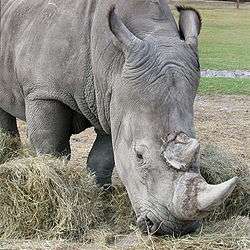Definify.com
Webster 1913 Edition
Rhinoceros
Rhi-noc′e-ros
(rī̍-nŏs′ē̍-rŏs)
, Noun.
[L., fr. Gr.
ῥινοκέρως
, ῥινοκέρωτος
; ῥίς
, ῥινός
, the nose + κέρασ
a horn: cf. F. rhinocéros
. See Horn
.] (Zool.)
Any pachyderm belonging to the genera
Rhinoceros
, Atelodus
, and several allied genera of the family Rhinocerotidae
, of which several living, and many extinct, species are known. They are large and powerful, and usually have either one or two stout conical median horns on the snout. ☞ The Indian, or white, and the Javan rhinoceroses (
Rhinoceros Indicus
and Rhinoceros Sondaicus
) have incisor and canine teeth, but only one horn, and the very thick skin forms shieldlike folds. The two or three African species belong to Atelodus
, and have two horns, but lack the dermal folds, and the incisor and canine teeth. The two Malay, or East Indian, two-horned species belong to Ceratohinus
, in which incisor and canine teeth are present. See Borele
, and Keitloa
. Rhinoceros auk
(Zool.)
, an auk of the North Pacific (
– Cerorhina monocrata
) which has a deciduous horn on top of the bill. Rhinoceros beetle
(Zool.)
, a very large beetle of the genus
– Dynastes
, having a horn on the head. Rhinoceros bird
. (Zool.)
(a)
A large hornbill (
. See Buceros rhinoceros
), native of the East Indies. It has a large hollow hornlike process on the bill. Called also rhinoceros hornbill
Hornbill
. (b)
An African beefeater (
Buphaga Africana
). It alights on the back of the rhinoceros in search of parasitic insects.Webster 1828 Edition
Rhinoceros
RHINOC'EROS
,Noun.
A genus of quadrupeds of two species, one of which, the unicorn, as a single horn growing almost erect from the nose. This animal when full grown, is said to be 12 feet in length. There is another species with two horns, the bicornis. They are natives of Asia and Africa.
Definition 2025
rhinoceros
rhinoceros
See also: rhinocéros
English

A rhinoceros.
Noun
rhinoceros (plural rhinoceros or rhinoceroses or (nonstandard) rhinoceri or (archaic) rhinocerotes)
- Any of several large herbivorous pachyderms native to Africa and Asia of the five extant species in the three extant genera in the family Rhinocerotidae, with thick, gray skin and one or two horns on their snouts.
- 1658, Brown, Thomas, “Of Unicorns Horn”, in Pseudodoxia Epidemica: Or Enquiries Into Very many Received Tenents And commonly Presumed Truths. The Fourth Edition, page 203:
- Herein therefore to draw up our determinations beside the several pieces of Scripture mentioning this Animal (which some may well contend to be only meant of the Rhinoceros) we are so far from denying there is any Unicorn at all, that we affirme there are many kinds thereof. In the number of Quadrapedes we will concede no less then five; that is the Indian Oxe, Indian Ass, Rhinoceros, the Oryx, and that which is more eminently termed Monoceros, or Unicornis.
-
Hyponyms
- black rhinoceros
- Indian rhinoceros
- Javan rhinoceros
- lesser one-horned rhinoceros
- Sumatran rhinoceros
- white rhinoceros
- woolly rhinoceros
Translations
herbivorous pachyderm with horn(s)
|
|
See also
Latin
Etymology
From Ancient Greek ῥινόκερως (rhinókerōs)
Pronunciation
- (Classical) IPA(key): /riːˈno.ke.roːs/, [riːˈnɔ.kɛ.roːs]
Noun
rhīnocerōs m (genitive rhīnocerōtis); third declension
- rhinoceros
- vessel made of a rhinoceros's horn
- nickname for someone with a long nose
Inflection
Third declension.
| Case | Singular | Plural |
|---|---|---|
| nominative | rhīnocerōs | rhīnocerōtēs |
| genitive | rhīnocerōtis | rhīnocerōtum |
| dative | rhīnocerōtī | rhīnocerōtibus |
| accusative | rhīnocerōta rhīnocerōtem |
rhīnocerōtas rhīnocerōtēs |
| ablative | rhīnocerōte | rhīnocerōtibus |
| vocative | rhīnocerōs | rhīnocerōtēs |
References
- rhinoceros in Karl Ernst Georges, Ausführliches lateinisch-deutsches Handwörterbuch
- rhinoceros in Charlton T. Lewis and Charles Short (1879) A Latin Dictionary, Oxford: Clarendon Press
- rhinoceros in Charlton T. Lewis (1891) An Elementary Latin Dictionary, New York: Harper & Brothers
- Félix Gaffiot (1934), “rhinoceros”, in Dictionnaire Illustré Latin-Français, Paris: Hachette.